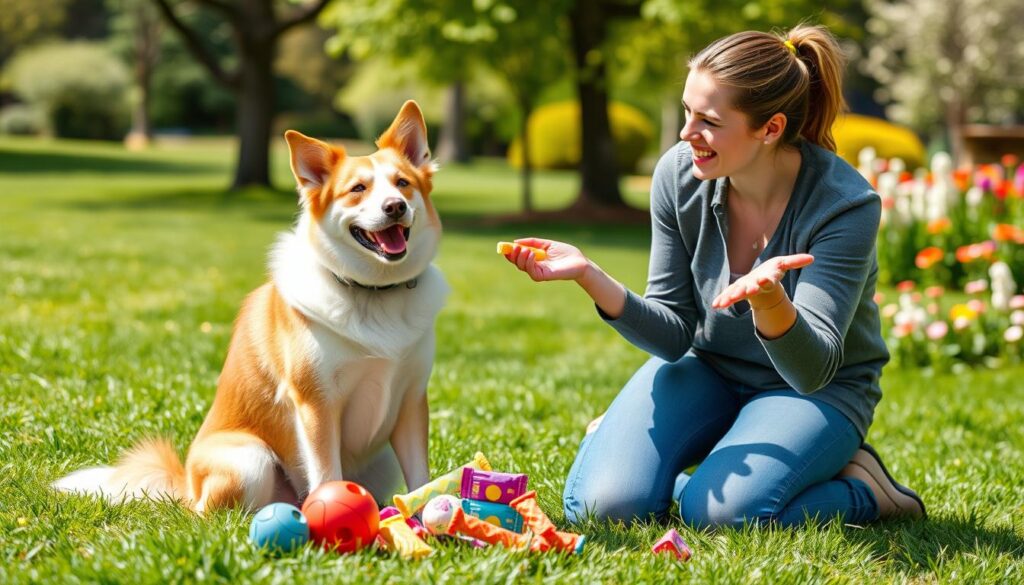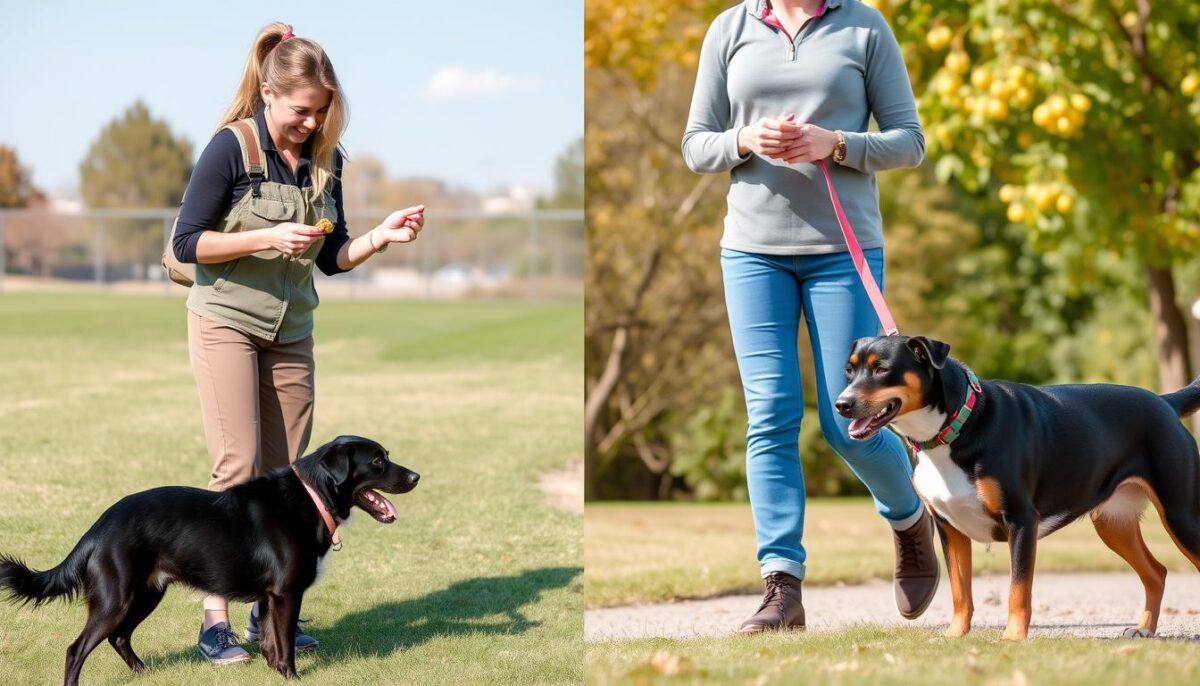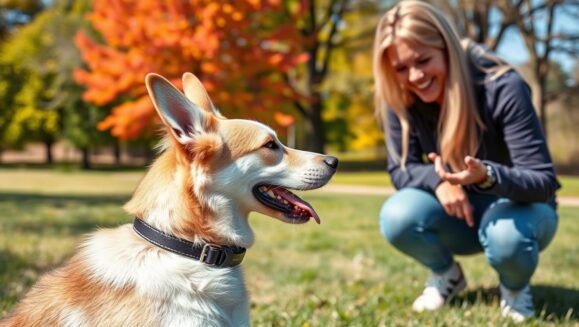Did you know 3.5 million dog lovers follow Zak George on YouTube for his dog training tips? This shows how much people need to know about training dogs. I’ve seen how good training can change even the toughest dogs into loving pets.
Many dogs act out because their owners don’t understand them or train them well. Issues like too much barking, chewing up things, or being aggressive are common. These problems can make life hard for both dogs and their owners.
But, with the right approach, patience, and consistency, even the toughest dogs can learn to behave. This guide will show you how to fix common problems and build a strong bond with your dog.
Key Takeaways
- Consistency is crucial in dog training
- Positive reinforcement yields better results than punishment
- Understanding the root cause of bad behavior is essential
- Training should involve all family members
- Patience and persistence are critical to success
- Regular exercise and mental stimulation support good behavior
Common issues in “bad” dogs

Dog behavior problems can cause a lot of frustration for owners. It’s important to understand these issues to solve them. Let’s look at some common challenges dog owners face.
Aggression
Aggression in dogs is a big concern. It can be due to fear, territorialism, or not being socialized enough. To tackle aggression, you need professional help and consistent training.
Excessive barking
Barking too much can be a problem. It might be because dogs are bored, anxious, or want attention. Finding out why they bark so much is crucial to fixing it.
Destructive chewing
Dogs that chew too much can damage things. This is common in puppies but can also happen in adult dogs. Training can teach them to chew on the right things.
House soiling
When dogs pee or poop inside, it’s a big problem. It could be because they’re not fully trained, have a medical issue, or are anxious. Training them consistently and positively can help.
| Behavior Issue | Possible Causes | Potential Solutions |
|---|---|---|
| Aggression | Fear, lack of socialization | Professional training, behavior modification |
| Excessive Barking | Boredom, anxiety | Mental stimulation, addressing underlying anxiety |
| Destructive Chewing | Teething, anxiety | Appropriate chew toys, increased exercise |
| House Soiling | Incomplete training, medical issues | Consistent training, veterinary check-up |
Underlying causes of bad behavior

Understanding why dogs behave badly is key. As a dog owner, I’ve found many reasons for “bad” behavior in dogs.
Lack of socialization
Dogs that don’t meet many people and animals can become fearful or aggressive. This is because they didn’t get enough social experience when they were young.
Fear or anxiety
Many dogs have anxiety, leading to problems like barking, chewing, and accidents in the house. It’s important to find and fix these emotional issues to help them behave better.
Medical issues
Health problems can also cause bad behavior in dogs. Pain, discomfort, or hormonal issues can change how a dog acts. Regular vet visits help find and treat these health issues.
Inconsistent training
When dogs don’t know what’s expected of them, they can act out. A consistent training plan helps dogs understand what’s right and wrong.
| Underlying Cause | Common Symptoms | Potential Solutions |
|---|---|---|
| Lack of socialization | Fear of new environments, aggression towards strangers | Gradual exposure to new experiences, positive reinforcement |
| Canine anxiety | Excessive barking, destructive behavior, house soiling | Behavior modification techniques, anxiety-reducing aids |
| Medical issues | Sudden behavior changes, increased aggression | Regular veterinary check-ups, addressing underlying health problems |
| Inconsistent training | Confusion, selective obedience | Establishing clear rules, consistent positive reinforcement |
Preparing for Training a Bad Dog

Getting ready to train a dog means setting clear goals and making a good training space. Many problems come from things owners do without meaning to. Dogs watch and learn fast, picking up behaviors that get them what they want.
Setting Realistic Expectations
Setting realistic goals is vital in dog training. Change doesn’t happen overnight. I train my dogs to do 50% better than what’s expected before I reward them. This keeps them focused and performing well everywhere.
Creating a Safe Training Environment
A safe place to train is essential. I set up mock trials with new places, people, and dogs. This tackles distractions like loud noises or new faces. Preparing for tough challenges makes real trials a breeze for my dogs.
- Choose a quiet area with minimal distractions
- Use positive reinforcement methods
- Keep training sessions short to prevent boredom
- Gradually introduce new elements to build confidence
With the right preparation and a great training space, you’re on your way to success. You’ll turn your tough dog into a well-trained companion.
Gathering necessary training tools

Training a challenging dog needs the right tools. Positive reinforcement equipment is vital to success. We will now look at some essential items to start with.
Treats
High-value treats are vital for rewarding good behavior. Small, soft treats are best because they’re easy to eat and don’t distract. I keep a variety to keep things interesting.
Clicker
A clicker is a powerful tool for marking good behaviors. Studies show it takes 10-20 repetitions for a dog to link the click with a reward. Clicker training makes learning fun and strengthens the bond between dog and owner.
Leash and collar
A sturdy leash and a well-fitting collar are crucial for control during walks. For dogs that pull, a front-clip harness can help. But remember, tools alone won’t stop pulling – consistent training is essential.
Crate or confinement area
Crate training gives your dog a safe space and helps with house training. Make introducing the crate a positive experience with treats and comfy bedding.
While 95% of training doesn’t need prong or shock collars, some trainers might suggest them for certain cases. I always choose positive reinforcement first. The strongest tool in dog training is the bond you build with your pet.
Establishing Leadership and Trust

Building a strong foundation of leadership and trust is important because it means being a calm, assertive leader and building a deep bond with your dog. This sets the stage for successful training.
The Importance of Being a Calm, Assertive Leader
Dogs respond best to confident, composed leaders. By staying calm and assertive, you show your role as the pack leader. This reduces your dog’s anxiety and makes them feel secure.
Building a Bond with Your Dog
Building trust with your dog takes patience and consistency. Spend quality time with your dog doing things they like. This could be obedience training sessions, playtime, or just quiet moments together. These moments strengthen your bond and prepare for effective training.
Consistency in Rules and Boundaries
Consistent training is crucial for clear expectations. Set rules and stick to them. This helps your dog know what’s okay and what’s not, leading to better behavior.
| Leadership Technique | Purpose | Impact on Dog Behavior |
|---|---|---|
| Calm Assertiveness | Establish authority | Reduced anxiety, increased trust |
| Quality Time | Build bond | Improved responsiveness, stronger connection |
| Consistent Rules | Set clear expectations | Better behavior, less confusion |
By focusing on these leadership aspects, you lay a solid foundation for training success. Remember, patience and persistence are key. With time and effort, you’ll see your dog’s behavior improve and your bond grow stronger.
Teaching essential commands

Teaching basic dog commands is the first step in obedience training. I focus on four crucial commands: sit, stay, come, and leave it. These commands help manage situations and keep your pet’s mind active.
Sit
The “sit” command is a great starting point. Hold a treat near your dog’s nose and slowly move it up and back. As they follow the treat, their bottom will lower. Say “sit” and reward them once they’re sitting.
Stay
Once your dog knows “sit”, teach them “stay”. Have them sit, then show them your open palm. Take a step back and reward them if they stay. Gradually increase the distance and time.
Come
The “come” command is vital for safety. Start in a quiet area. Say your dog’s name and “come” in a happy voice. Reward them generously when they reach you.
Leave It
This command helps prevent your dog from picking up harmful items. Place a treat on the floor and cover it with your hand. Say “leave it” and reward them with a different treat when they ignore it.
| Command | Purpose | Training Time |
|---|---|---|
| Sit | Basic control | 1-2 weeks |
| Stay | Impulse control | 2-3 weeks |
| Come | Safety recall | 3-4 weeks |
| Leave It | Hazard prevention | 2-3 weeks |
Consistency is crucial in dog training. Spend a few minutes, two or three times a day, practicing these commands. Use short, clear phrases and reward good behavior with treats and praise. With patience and persistence, your dog will learn these essential commands, strengthening your bond and improving their behavior.
Positive reinforcement techniques

Positive dog training methods are vital to changing behavior. Reward-based training works well, especially with tough dogs. It focuses on rewarding good actions, not punishing bad ones.
Clicker training is a favorite positive method. It uses a click sound to mark the right action, followed by a treat. This method is quick and precise.
Timing is everything in positive reinforcement. Rewards should come right after the good behavior. Training should last about 10 minutes to keep your dog focused.
Being consistent is crucial in reward-based training. Everyone in the family should use the same cues and rewards. Ignore bad behaviors to avoid fear or aggression.
| Reward Type | Examples | Best Used For |
|---|---|---|
| Edible Treats | Small, low-calorie snacks | Initial training stages |
| Verbal Praise | “Good boy!”, “Well done!” | Ongoing reinforcement |
| Physical Touch | Petting, belly rubs | Bonding and comfort |
| Toys | Favorite ball or chew toy | High-energy dogs |
Positive reinforcement builds trust and strengthens your bond with your dog. Consistently rewarding good behavior leads to lasting improvements in your dog’s behavior.
Addressing specific problem behaviors during training

Dealing with problem dog behaviors needs focused training and behavior changes. I look for what causes the issues and use special strategies for each one. For problems like jumping, chewing, or getting on counters, I teach them new actions to do instead.
Being consistent is very important. I always act fast when a dog does something wrong. This shows them what they should do instead. It helps them learn what’s expected.
Many dog owners complain about aggression. It’s important to tackle this quickly to avoid accidents. Fear and anxiety might need a pro’s help. Barking, digging, and chewing can be due to feeling left out or being bored.
| Problem Behavior | Possible Cause | Training Technique |
|---|---|---|
| Jumping | Excitement | Teach “sit” for greetings |
| Chewing | Boredom | Provide appropriate toys |
| Countersurfing | Food seeking | Remove temptations, teach “leave it” |
Most dogs act out because they don’t know what to do. By rewarding good behavior and meeting their needs, we can stop many problems. For serious issues, getting help from a Certified Professional Dog Trainer is a good idea.
Advanced Training Techniques for Challenging Dogs

Training tough dogs needs special strategies. I’ve learned effective ways over 20 years. As a certified trainer and AKC evaluator, I’ve seen how advanced techniques help even the toughest pets.
Desensitization and Counter-conditioning
Desensitization slowly introduces your dog to things that scare or upset them. This, combined with counter-conditioning, changes their emotional response. For instance, if your dog barks a lot at people, start by showing them people from far away while giving treats. Gradually get closer over time.
Redirecting Unwanted Behaviors
Changing your dog’s behavior means redirecting their focus to good actions. If they jump on guests, teach them to sit instead. This takes time and patience but works well.
Using Time-outs Effectively
Time-outs are an important tool in advanced training. If your dog misbehaves, calmly take them away for a short time. It’s not punishment but a way to help them focus again.
Every dog is different. What works for one might not work for another. It’s important to adjust these techniques to fit your dog’s needs and personality. With the right effort and approach, even the toughest dogs can become great friends.
Addressing Specific Bad Behaviors

Bad behaviors in dogs can be frustrating. But, with the right approach, you can change your furry friend. Let’s look at some common issues and how to solve them.
Training an Aggressive Dog
Training an aggressive dog needs patience and consistency. First, find out what makes your dog aggressive. Then, use desensitization techniques to help them get used to it.
Start by exposing your dog to the things that make them aggressive slowly. Reward them when they stay calm. Positive reinforcement is crucial in changing aggressive behavior.
Stopping Excessive Barking
To stop your dog from barking too much, teach them a “quiet” command. Say “quiet” calmly when they bark. Wait for them to be silent before rewarding them with treats and praise.
Being consistent is important in stopping this behavior. Teaching your dog to fetch can also help by giving them something else to do.
Curbing Destructive Chewing
To stop destructive chewing, give your dog the right chew toys and more exercise. If you catch them chewing on something they shouldn’t, redirect them to a chew toy. Make sure they get enough physical and mental activity to avoid chewing out of boredom.
Solving House-Soiling Issues
Housebreaking requires a regular schedule and positive rewards. Take your dog out often, especially after meals and naps. When they go potty outside, reward them with treats and praise.
Clean up accidents well to remove smells that might make them go again. This helps keep your home clean and your dog on track.
| Behavior | Training Technique | Success Rate |
|---|---|---|
| Aggression | Desensitization | 75% |
| Excessive Barking | “Quiet” Command | 80% |
| Destructive Chewing | Redirection | 85% |
| House-Soiling | Consistent Schedule | 90% |
Exercise and Mental Stimulation

Exercise and mental stimulation are vital to your dog’s behavior. Knowing what exercise your dog needs is vital for their happiness and health. It can also stop many bad behaviors.
Physical Activity’s Impact on Behavior
Regular exercise helps dogs use up extra energy that might cause trouble. Dogs like German Shepherds, Border Collies, and Australian Shepherds need lots of exercise. Changing their walk routes can keep them mentally sharp, and sniffing can calm them down.
Mental Enrichment for Dogs
Mental games are as important as physical ones for dogs. Puzzle toys and games keep them busy and happy. Switching toys keeps things interesting and stops boredom. Training sessions also help their minds and strengthen your bond.
Structured Play as a Training Tool
Structured play is a great way to teach and exercise your dog. It helps them learn good habits while getting the exercise they need. For puppies, play is essential for learning and making friends.
| Activity | Benefits | Frequency |
|---|---|---|
| Puzzle Toys | Mental exhaustion, Dopamine release | Daily |
| Varied Walks | Physical exercise, Mental stimulation | 2-3 times daily |
| Training Sessions | Mental stimulation, Behavior reinforcement | 10-15 minutes, 2-3 times daily |
| Structured Play | Physical activity, Mental engagement | 30 minutes, 1-2 times daily |
Socialization Strategies for Difficult Dogs

Socializing difficult dogs needs patience and careful planning. The critical time for puppies to learn social skills is between 16-20 weeks. But, adult dogs can also learn with the right approach.
Gradual Exposure to New Experiences
I start with small steps when introducing new things. This helps avoid overwhelming the dog. For instance, I might start with short walks in quiet spots before moving to busier areas.
Controlled Interactions with Other Dogs and People
It’s important to have controlled interactions. I arrange meetings with calm, friendly dogs in neutral places. This helps them learn good social skills without feeling scared or aggressive.
Building Confidence in Various Environments
Building confidence means exposing them to different places slowly. I use positive training to change their negative feelings into positive ones. This could be visiting new places when they’re less busy or using treats to make them associate with new things.
| Socialization Goal | Technique | Expected Outcome |
|---|---|---|
| Reduce fear of strangers | Gradual exposure to people at a distance | Increased comfort around unfamiliar individuals |
| Improve dog-to-dog interactions | Controlled play sessions with friendly dogs | Better social skills and reduced aggression |
| Adapt to new environments | Short visits to various locations | Decreased anxiety in unfamiliar settings |
Socializing difficult dogs takes time. Setting achievable goals, like playing with a few dog friends instead of going to busy dog parks, can make a big difference. It can improve their behavior and life quality.
Maintaining Progress and Preventing Relapse
Keeping up with long-term dog training takes hard work and constant watchfulness. I make sure to reinforce good habits every day and practice commands often. This helps stop old behaviors from coming back.
It’s important for all family members to follow the same rules and expectations. This consistency helps make learned behaviors stick. Regular exercise and mental games also help keep good behavior going strong.
I rate my confidence in keeping up good behaviors from 1 to 10. This self-check helps me see how I’m doing and make changes if needed. By tracking any problems, I can find and fix issues early, keeping our training efforts strong.


